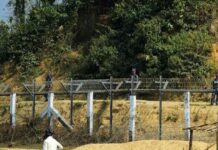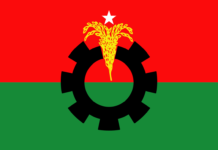
Villagers push a cartload of belongings and walk homewards after spending a night at a shelter in Cox’s Bazar on Tuesday after a tropical storm lashed southern Bangladesh. — AP photo
Thousands of people are living in the open sky as severe cyclonic storm Mora lashed Bangladesh’s southeastern coast, damaging thousands of houses and blowing over trees Tuesday morning.
At least seven people were killed and dozens were injured in the cyclone that sent fishing boats and ships aground and knocked out power connections to thousands of houses in almost entire Cox’s Bazar and parts of Chittagong.
The cyclone made landfall near fishing port Cox’s Bazar at about 6:00am with a wind speed of 139 kilometres per hour and heavy rainfall. The highest wind speed during the storm was recorded 146 km per hour in Chittagong. Low lying areas in Cox’s Bazar and Chittagong were inundated because of heavy rainfall.
‘We are lucky that the storm hit the land during the ebb,’ said Met official Bazlur Rashid.
‘As a result the storm surge did not become deadly,’ he added.
The Bangladesh Meteorological Department said that the storm weakened gradually as it moved inland to higher ground after making the landfall. It turned into a land depression by noon. It was lying on Rangamati till filing of the report and kept moving in a northerly direction toward Mizoram in India.
The Met Office downgraded its danger signal 10 issued earlier for Chittagong, Cox’s Bazar port and danger signal 8 for Mangla and Payra ports to cautionary signal 3 at about 1:00pm.
About half a million evacuated people started for their homes from about 3,600 cyclone shelters in 15 coastal districts after the Met Office lowered the cautionary signal.
They struggled to get back home as roads were littered with uprooted trees, electric poles and parts of damaged houses and establishments.

Many discovered only after reaching home that they did not have a place to spend the night in. There houses were gone with the storm.
There sufferings knew no bounds as it was still raining till filing of this report. Met officials said the rain might continue throughout the night.
‘Over half the inhabitants in Saint Martin’s island got their houses destroyed by the storm,’ said Abdur Rahim Jihadi, a resident of the island.
‘They can do nothing, but get wet in the rain,’ he added.
New Age correspondent in Cox’s Bazar reported that 17,000 houses were completely destroyed by the cyclone and 35,000 houses were partly damaged in the district.
At least four people were killed in Chakaria and district town during the cyclone. Three of the deceased were identified as Mariam Begum, Rahmat Ullah and Sayera Khatun. The identity of the fourth victim could not be established.
At least a dozen people were also injured.
The fate of about a 1,000 fishermen, who had gone fishing by about 80 boats in the sea before the storm slammed into the coast, could not yet be known.
Cox’s Bazar mechanised fishing boat owners’ association general secretary Mustaq Ahmad said that they were trying to contact the fishermen over cell phone without any luck.
In Cox’s Bazar town and elsewhere in the district, people lived without power as the cyclone damaged 23 transformers in the district.
State minister for power, energy and mineral resources told journalists in Dhaka that it would take two days to get all the transformers back to operation.
The power transmission and distribution in the Chittagong Hill Tracts was also hampered, reported New Age correspondent Rangamati.
Power Development Board executive engineer in Rangamati Sabuj Kanti Majumder said that the storm damaged the power distribution system badly.
Two were killed in Rangamati in the cyclone.
New Age correspondent in Chittagong reported that the cyclone completely damaged 25,096 houses and affected 1,40,088 people.
A ship, Crystal Gold, anchored at Chittagong port’s outer anchorage, ran aground near Parki Sea Beach area at Anwara in Chittagong by the storm.
Operations at Chittagong port resumed at 4:00pm. The operation was suspended ahead of the storm Monday morning.
Operations at Shah Amant International Airport also resumed at 6:00am Tuesday, about eight hours after authorities shut down the airport.
The low-lying areas in Chittagong city, including Agrabad, Halishahar, Patenga, Bakalia, Chawkbazar, Sholoshahar, Prabartak crossing and Muradpur, went under knee-deep water because of heavy rainfall that came with the cyclone. The rain continued throughout the day and did not show any sign of ceasing till filing of this report.
The city experienced 64mm rainfall in the past 24 hours till 6:00pm.
New Age correspondent in Bhola reported that a one-year-old boy died when his mother was running to a cyclone shelter early Tuesday.
As reports of damage caused by the storm continued to come, the government said that it would take some time to prepare a complete assessment of the losses from the cyclone.
At a press conference, acting disaster management and relief Secretary Golam Mostafa said that deputy commissioners were assessing the loss.
He said that 468,000 people took shelter in 3,600 cyclone shelters.
According to him, the ministry allocated 1,400 tonnes of rice and Tk 1.46 crore in cash to help the cyclone affected people.
The Inter Service Public Relations in a release said that two navy ships and 400 members of the navy were working in Kutubdia and Saint Martin’s island in immediate aid to the cyclone affected people.
Bangladesh Nationalist Party chairperson Khaleda Zia twitted on Tuesday urging all to stand beside the cyclone affected people.
‘I ask everyone to stand by the Cyclone Mora affected people. I also pray that may Allah give them the strength to overcome this calamity,’ wrote Khaleda in her tweet.
Transports in the country’s inland river routes resumed Tuesday afternoon.
Source: New Age









